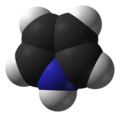Pyrrole
Pyrrole is a heterocyclic aromatic organic compound, a five-membered ring with the formula C4H4NH. It is a colorless volatile liquid that darkens readily upon exposure to air. Substituted derivatives are also called pyrroles, e.g., N-methylpyrrole, C4H4NCH3. Porphobilinogen, a trisubstituted pyrrole, is the biosynthetic precursor to many natural products such as heme.
Structure and bonding[edit]
Pyrroles are aromatic. Like furan and thiophene, the pyrrole ring is aromatic because it contains 4 π-electrons in the two double bonds plus one lone pair of electrons on the nitrogen. The lone pair on the nitrogen is not part of the aromatic π-system. Pyrroles are weakly basic, with a conjugate acid pKa of −3.8. The most basic site is C-2. Pyrroles are also weakly acidic at the N-H position, with a pKa of 17.5.
Preparation[edit]
Pyrrole can be prepared by treatment of furan with ammonia in the presence of acid catalysts, such as AlCl3. Pyrrole can also be formed by dehydrogenation of pyrrolidine.
Reactions[edit]
Pyrrole undergoes reactions that are characteristic of other aromatic compounds, notably electrophilic aromatic substitution. It is particularly susceptible to such reactions because of the electron-donating effect of the nitrogen. Hence, electrophiles attack pyrrole at the 2 position, then rearrangement of the intermediate σ-complex leads to substitution at the 3 position.
Applications[edit]
Pyrrole is a constituent of tobacco smoke and not as an ingredient. Pyrrole is used as a precursor to the drug tolmetin. Polypyrrole is of some commercial value.
See also[edit]
References[edit]
<references />
|
|
|
Pyrrole[edit]
-
Pyrrole 2D full
-
Pyrrole 2D numbered
-
Pyrrole CRC MW 3D balls A
-
Pyrrole CRC MW 3D vdW
-
Heme B
-
Pyrrolsynthese 1
-
Hantzsch Pyrrole Synthesis Scheme
-
Knorr Pyrrole Synthesis Scheme
-
Paal-Knorr Pyrrole Synthesis
-
Van Leusen Mechanism
-
Barton-Zard reaction
-
Piloty-Robinson reaction
Ad. Transform your life with W8MD's Budget GLP-1 injections from $75


W8MD offers a medical weight loss program to lose weight in Philadelphia. Our physician-supervised medical weight loss provides:
- Weight loss injections in NYC (generic and brand names):
- Zepbound / Mounjaro, Wegovy / Ozempic, Saxenda
- Most insurances accepted or discounted self-pay rates. We will obtain insurance prior authorizations if needed.
- Generic GLP1 weight loss injections from $75 for the starting dose.
- Also offer prescription weight loss medications including Phentermine, Qsymia, Diethylpropion, Contrave etc.
NYC weight loss doctor appointmentsNYC weight loss doctor appointments
Start your NYC weight loss journey today at our NYC medical weight loss and Philadelphia medical weight loss clinics.
- Call 718-946-5500 to lose weight in NYC or for medical weight loss in Philadelphia 215-676-2334.
- Tags:NYC medical weight loss, Philadelphia lose weight Zepbound NYC, Budget GLP1 weight loss injections, Wegovy Philadelphia, Wegovy NYC, Philadelphia medical weight loss, Brookly weight loss and Wegovy NYC
|
WikiMD's Wellness Encyclopedia |
| Let Food Be Thy Medicine Medicine Thy Food - Hippocrates |
Medical Disclaimer: WikiMD is not a substitute for professional medical advice. The information on WikiMD is provided as an information resource only, may be incorrect, outdated or misleading, and is not to be used or relied on for any diagnostic or treatment purposes. Please consult your health care provider before making any healthcare decisions or for guidance about a specific medical condition. WikiMD expressly disclaims responsibility, and shall have no liability, for any damages, loss, injury, or liability whatsoever suffered as a result of your reliance on the information contained in this site. By visiting this site you agree to the foregoing terms and conditions, which may from time to time be changed or supplemented by WikiMD. If you do not agree to the foregoing terms and conditions, you should not enter or use this site. See full disclaimer.
Credits:Most images are courtesy of Wikimedia commons, and templates, categories Wikipedia, licensed under CC BY SA or similar.
Translate this page: - East Asian
中文,
日本,
한국어,
South Asian
हिन्दी,
தமிழ்,
తెలుగు,
Urdu,
ಕನ್ನಡ,
Southeast Asian
Indonesian,
Vietnamese,
Thai,
မြန်မာဘာသာ,
বাংলা
European
español,
Deutsch,
français,
Greek,
português do Brasil,
polski,
română,
русский,
Nederlands,
norsk,
svenska,
suomi,
Italian
Middle Eastern & African
عربى,
Turkish,
Persian,
Hebrew,
Afrikaans,
isiZulu,
Kiswahili,
Other
Bulgarian,
Hungarian,
Czech,
Swedish,
മലയാളം,
मराठी,
ਪੰਜਾਬੀ,
ગુજરાતી,
Portuguese,
Ukrainian









